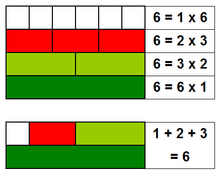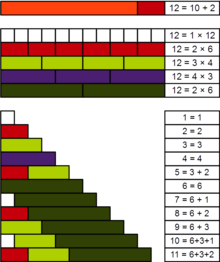Illustration of the perfect number status of the number 6
In number theory, a perfect number is a positive integer that is equal to the sum of its proper positive divisors, that is, the sum of its positive divisors excluding the number itself (also known as its aliquot sum). Equivalently, a perfect number is a number that is half the sum of all of its positive divisors (including itself) i.e. σ1(n) = 2n.
This definition is ancient, appearing as early as Euclid's Elements (VII.22) where it is called τέλειος ἀριθμός (perfect, ideal, or complete number). Euclid also proved a formation rule (IX.36) whereby
 is an even perfect number whenever
is an even perfect number whenever  is a prime of the form
is a prime of the form  for prime
for prime  —what is now called a Mersenne prime. Much later, Euler proved that all even perfect numbers are of this form. This is known as the Euclid–Euler theorem.
—what is now called a Mersenne prime. Much later, Euler proved that all even perfect numbers are of this form. This is known as the Euclid–Euler theorem.
It is not known whether there are any odd perfect numbers, nor whether infinitely many perfect numbers exist.
Examples
The first perfect number is 6. Its proper divisors are 1, 2, and 3, and 1 + 2 + 3 = 6. Equivalently, the number 6 is equal to half the sum of all its positive divisors: ( 1 + 2 + 3 + 6 ) ÷ 2 = 6. The next perfect number is 28: 28 = 1 + 2 + 4 + 7 + 14. This is followed by the perfect numbers 496 and 8128 (sequence A000396 in the OEIS).History
In about 300 BC Euclid showed that if 2p − 1 is prime then (2p − 1)2p−1 is perfect. The first four perfect numbers were the only ones known to early Greek mathematics, and the mathematician Nicomachus had noted 8128 as early as 100 AD. Philo of Alexandria in his first-century book "On the creation" mentions perfect numbers, claiming that the world was created in 6 days and the moon orbits in 28 days because 6 and 28 are perfect. Philo is followed by Origen, and by Didymus the Blind, who adds the observation that there are only four perfect numbers that are less than 10,000. (Commentary on Genesis 1. 14-19). St Augustine defines perfect numbers in City of God (Part XI, Chapter 30) in the early 5th century AD, repeating the claim that God created the world in 6 days because 6 is the smallest perfect number. The Egyptian mathematician Ismail ibn Fallūs (1194–1252) mentioned the next three perfect numbers (33,550,336; 8,589,869,056; and 137,438,691,328) and listed a few more which are now known to be incorrect. In a manuscript written between 1456 and 1461, an unknown mathematician recorded the earliest European reference to a fifth perfect number, with 33,550,336 being correctly identified for the first time. In 1588, the Italian mathematician Pietro Cataldi also identified the sixth (8,589,869,056) and the seventh (137,438,691,328) perfect numbers, and also proved that every perfect number obtained from Euclid's rule ends with a 6 or an 8.Even perfect numbers
Euclid proved that 2p−1(2p − 1) is an even perfect number whenever 2p − 1 is prime (Euclid, Prop. IX.36).For example, the first four perfect numbers are generated by the formula 2p−1(2p − 1), with p a prime number, as follows:
- for p = 2: 21(22 − 1) = 6
- for p = 3: 22(23 − 1) = 28
- for p = 5: 24(25 − 1) = 496
- for p = 7: 26(27 − 1) = 8128.
Nicomachus (60–120 AD) conjectured that every perfect number is of the form 2p−1(2p − 1) where 2p − 1 is prime. Ibn al-Haytham (Alhazen) circa 1000 AD conjectured that every even perfect number is of that form. It was not until the 18th century that Leonhard Euler proved that the formula 2p−1(2p − 1) will yield all the even perfect numbers. Thus, there is a one-to-one correspondence between even perfect numbers and Mersenne primes; each Mersenne prime generates one even perfect number, and vice versa. This result is often referred to as the Euclid–Euler theorem. As of January 2018, 50 Mersenne primes are known, and therefore 50 even perfect numbers (the largest of which is 277232916 × (277232917 − 1) with 46,498,850 digits).
An exhaustive search by the GIMPS distributed computing project has shown that the first 47 even perfect numbers are 2p−1(2p − 1) for
- p = 2, 3, 5, 7, 13, 17, 19, 31, 61, 89, 107, 127, 521, 607, 1279, 2203, 2281, 3217, 4253, 4423, 9689, 9941, 11213, 19937, 21701, 23209, 44497, 86243, 110503, 132049, 216091, 756839, 859433, 1257787, 1398269, 2976221, 3021377, 6972593, 13466917, 20996011, 24036583, 25964951, 30402457, 32582657, 37156667, 42643801, and 43112609 (sequence A000043 in the OEIS).
As well as having the form 2p−1(2p − 1), each even perfect number is the (2p − 1)th triangular number (and hence equal to the sum of the integers from 1 to 2p − 1) and the 2p−1th hexagonal number. Furthermore, each even perfect number except for 6 is the ((2p + 1)/3)th centered nonagonal number and is equal to the sum of the first 2(p−1)/2 odd cubes:
Owing to their form, 2p−1(2p − 1), every even perfect number is represented in binary as p ones followed by p − 1 zeros; for example,
- 610 = 1102
- 2810 = 111002
- 49610 = 1111100002
- 812810 = 11111110000002.
Note that every even perfect number is also a practical number.
Odd perfect numbers
It is unknown whether there is any odd perfect number, though various results have been obtained. In 1496, Jacques Lefèvre stated that Euclid's rule gives all perfect numbers, thus implying that no odd perfect number exists. More recently, Carl Pomerance has presented a heuristic argument suggesting that indeed no odd perfect number should exist. All perfect numbers are also Ore's harmonic numbers, and it has been conjectured as well that there are no odd Ore's harmonic numbers other than 1.Any odd perfect number N must satisfy the following conditions:
- N > 101500.
- N is not divisible by 105.
- N is of the form N ≡ 1 (mod 12), N ≡ 117 (mod 468), or N ≡ 81 (mod 324).
- N is of the form
-
- where:
- The largest prime factor of N is greater than 108.
- The second largest prime factor is greater than 104, and the third largest prime factor is greater than 100.
- N has at least 101 prime factors and at least 10 distinct prime factors. If 3 is not one of the factors of N, then N has at least 12 distinct prime factors.
...a prolonged meditation on the subject has satisfied me that the existence of any one such [odd perfect number] — its escape, so to say, from the complex web of conditions which hem it in on all sides — would be little short of a miracle.Euler stated: "Whether (...) there are any odd perfect numbers is a most difficult question".
Minor results
All even perfect numbers have a very precise form; odd perfect numbers either do not exist or are rare. There are a number of results on perfect numbers that are actually quite easy to prove but nevertheless superficially impressive; some of them also come under Richard Guy's strong law of small numbers:- The only even perfect number of the form x3 + 1 is 28 (Makowski 1962).
- 28 is also the only even perfect number that is a sum of two positive cubes of integers (Gallardo 2010).
- The reciprocals of the divisors of a perfect number N must add up to 2 (to get this, take the definition of a perfect number,
, and divide both sides by n):
- For 6, we have
;
- For 28, we have
, etc.
- For 6, we have
- The number of divisors of a perfect number (whether even or odd) must be even, because N cannot be a perfect square.
- From these two results it follows that every perfect number is an Ore's harmonic number.
- The even perfect numbers are not trapezoidal numbers; that is, they cannot be represented as the difference of two positive non-consecutive triangular numbers. There are only three types of non-trapezoidal numbers: even perfect numbers, powers of two, and the numbers of the form
formed as the product of a Fermat prime
with a power of two in a similar way to the construction of even perfect numbers from Mersenne primes.
- The number of perfect numbers less than n is less than
, where c > 0 is a constant. In fact it is
, using little-o notation.
- Every even perfect number ends in 6 or 28, base ten; and, with the only exception of 6, ends in 1, base 9. Therefore in particular the digital root of every even perfect number other than 6 is 1.
- The only square-free perfect number is 6.
Related concepts
The sum of proper divisors gives various other kinds of numbers. Numbers where the sum is less than the number itself are called deficient, and where it is greater than the number, abundant. These terms, together with perfect itself, come from Greek numerology. A pair of numbers which are the sum of each other's proper divisors are called amicable, and larger cycles of numbers are called sociable. A positive integer such that every smaller positive integer is a sum of distinct divisors of it is a practical number.By definition, a perfect number is a fixed point of the restricted divisor function s(n) = σ(n) − n, and the aliquot sequence associated with a perfect number is a constant sequence. All perfect numbers are also
 -perfect numbers, or Granville numbers.
-perfect numbers, or Granville numbers.A semiperfect number is a natural number that is equal to the sum of all or some of its proper divisors. A semiperfect number that is equal to the sum of all its proper divisors is a perfect number. Most abundant numbers are also semiperfect; abundant numbers which are not semiperfect are called weird numbers.

![{\begin{aligned}6&=2^{1}(2^{2}-1)&&=1+2+3,\\[8pt]28&=2^{2}(2^{3}-1)&&=1+2+3+4+5+6+7=1^{3}+3^{3},\\[8pt]496&=2^{4}(2^{5}-1)&&=1+2+3+\cdots +29+30+31\\&&&=1^{3}+3^{3}+5^{3}+7^{3},\\[8pt]8128&=2^{6}(2^{7}-1)&&=1+2+3+\cdots +125+126+127\\&&&=1^{3}+3^{3}+5^{3}+7^{3}+9^{3}+11^{3}+13^{3}+15^{3},\\[8pt]33550336&=2^{12}(2^{13}-1)&&=1+2+3+\cdots +8189+8190+8191\\&&&=1^{3}+3^{3}+5^{3}+\cdots +123^{3}+125^{3}+127^{3}.\end{aligned}}](https://wikimedia.org/api/rest_v1/media/math/render/svg/9fa183786d803ce1cab48875dabc4b697ee59225)


































